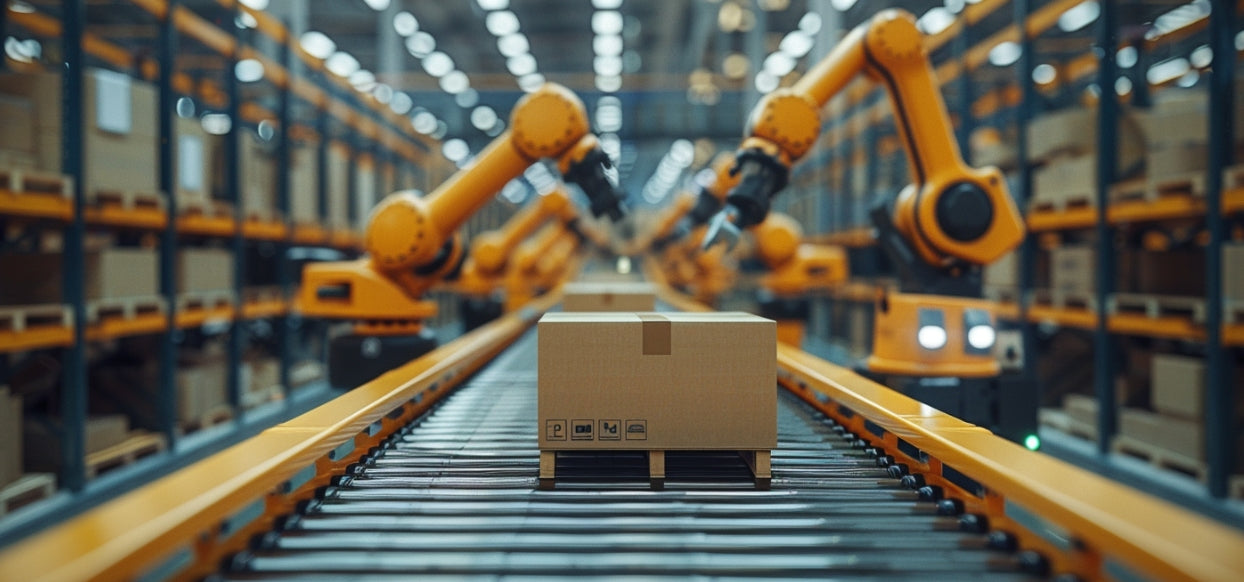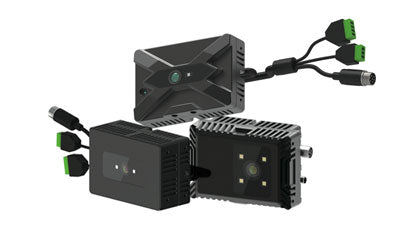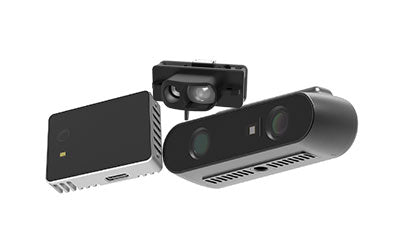TOF in Smart Warehousing: Enhancing Navigation, Sensing & Efficiency

With the rapid advancement of automation and intelligence in the warehousing and logistics industry, spatial perception technology has become a core factor in improving warehouse operation efficiency and safety. As a high-precision 3D sensing technology, TOF (Time of Flight) sensors are gradually becoming an indispensable key technology in smart warehousing due to their accurate depth measurement and fast response capabilities.
What is the meaning of Smart Warehousing?
'Smart Warehousing' refers to the modern warehousing model that utilizes advanced technologies and automated systems to enhance warehouse management and operational efficiency. It employs IoT, big data, AI, and automated equipment (such as robots and automated picking systems) to achieve precise inventory management, real-time goods tracking, and intelligent operational processes, thereby reducing costs and improving speed and accuracy. Simply put, it uses smart technology to make warehouses more efficient, flexible, and secure.
Core Spatial Perception Needs for Automated Warehousing
Modern smart warehousing relies on AGVs (Automated Guided Vehicles) and robots for cargo handling, stacking, and inventory management. These devices must have precise environmental perception and path planning abilities to realize efficient and safe autonomous operations. Spatial perception requires real-time capture of warehouse shelves, obstacles, and dynamic environments, while integrating with warehouse management systems for real-time inventory updates.
Application of TOF Technology in AGV Path Navigation and Obstacle Detection
As intelligent logistics systems evolve towards 'unmanned' and 'high flexibility,' the use of AGVs in warehousing and production scenarios is becoming more widespread. To achieve safe and efficient movement in complex and variable environments, AGVs demand higher environmental perception systems. 3D TOF camera-based depth sensing technology is gradually becoming a key component of AGV path navigation and obstacle detection.
TOF technology emits modulated light and measures the round-trip flight time to build a 3D point cloud of the scene, capturing real-time depth information of the surroundings. Compared to traditional LiDAR, TOF offers greater precision in short-range sensing, as well as advantages in cost, size, and power consumption; compared to monocular or stereo vision systems, TOF’s ranging stability does not depend on texture features or external lighting, offering stronger environmental adaptability.
In practical AGV applications, TOF cameras are usually installed at the front or corners of the vehicle, working with SLAM algorithms or path planning modules to perform key functions such as:
-
Real-time obstacle detection and avoidance: Quickly sensing obstacles (like pallets, pedestrians, stacks) ahead and dynamically adjusting the driving path;
-
Precise docking and alignment: Assisting AGVs in centimeter-level alignment during pallet handling and shelf docking to improve operational accuracy;
-
High adaptability in dynamic environments: Maintaining continuous perception in warehouses with frequent personnel flow and stacking to avoid collisions;
-
Low power consumption and lightweight deployment: Due to the small size and low power of TOF modules, they are especially suitable for integration into micro-AGVs, AMRs (Autonomous Mobile Robots), or unmanned tuggers, without affecting vehicle structure or endurance.
New-generation industrial-grade TOF modules, represented by domestic manufacturers such as Benewake, support industrial communication protocols like Modbus 485 and CAN, seamlessly integrating with AGV control systems. They also feature high frame rates and strong anti-interference capabilities, suitable for stable long-term operation in complex working conditions.
In the future, as TOF sensors further integrate deeply with AI chips, SLAM algorithms, and VIO inertial navigation modules, their role in AGV systems will evolve from merely a 'perception frontend' to an 'intelligent visual hub' capable of real-time decision-making and prediction, providing more flexible, safer, and smarter autonomous driving perception solutions for smart logistics.
Multi-Sensor Fusion: Intelligent Collaboration of TOF + Barcode/RFID + LiDAR
In the progression towards high-precision, high-efficiency, and fully automated smart warehousing, multi-sensor fusion is gradually becoming a core technological pathway. By integrating TOF sensors, barcode/RFID recognition systems, and LiDAR, warehousing systems can achieve richer and more accurate environmental perception and data analysis, enabling quick and reliable decision-making in dynamic and complex logistics scenarios.
In this fusion architecture, TOF sensors play a key role in real-time 3D spatial perception by capturing geometric information such as shelf structures, aisle obstacles, and stack volumes, constructing dynamic depth maps to strongly support navigation and obstacle avoidance;
barcode scanners and RFID readers provide static information identification channels, quickly reading unique IDs of goods (e.g., SKU, batch number, storage time), suitable for inbound, picking, and outbound traceability and flow management; LiDAR, with its high-precision long-distance scanning ability, complements TOF’s limitations in long-range perception and is used for path planning, warehouse-wide map construction, and dynamic obstacle tracking.
Each of these three sensors performs complementary roles. Through algorithmic fusion processing (such as Kalman filtering and deep learning fusion models), the Warehouse Management System (WMS/WCS) can accurately build a real-time 3D warehouse environment model, improving the spatial matching between goods and environment, and enabling intelligent path optimization, dynamic task scheduling, and anomaly warning.
For example, in an 'unmanned warehouse' application, an AGV uses a TOF module for path obstacle avoidance and shelf positioning, an RFID antenna to identify target goods IDs, and LiDAR for warehouse mapping and path replanning. Even in multi-vehicle collaboration or temporarily changing environments, efficient and safe dynamic scheduling can be achieved.
Moreover, multi-sensor fusion helps with data redundancy and fault tolerance in complex environments. When one sensor temporarily fails or is blocked, other perception modules can compensate in real time, enhancing system robustness and continuity. This 'perception redundancy + intelligent decision-making' strategy is key to building the next-generation intelligent warehousing system.
With the maturation of AI chips and edge computing devices, future multi-sensor fusion systems will achieve better balance among cost, performance, and energy efficiency, driving smart warehousing to higher levels of collaborative control and adaptive optimization, realizing a truly 'perception—cognition—execution' closed-loop automated logistics system.
Key Technologies for Precision Modeling and Real-Time Inventory Updates
With the continued development of smart warehousing and the rise of "unmanned warehouses," high-precision modeling and dynamic inventory monitoring have become core elements in improving management efficiency and resource scheduling capabilities. By leveraging Time-of-Flight (TOF) sensors to capture high-density 3D depth data, combined with AI-based visual recognition and semantic segmentation algorithms, warehousing systems can achieve millimeter-level spatial modeling and tracking of shelves, pallets, and even individual items—enabling high-frequency, low-error inventory management.
TOF sensors measure the time it takes for emitted light signals to return, quickly generating 3D point clouds. These can precisely identify the shape, size, and stacking position of goods, while also detecting anomalies such as occlusion, tilting, or improper placement. This 3D spatial awareness is particularly effective in complex stacking scenarios or low-light environments where traditional vision systems often struggle.
Key Advantages and Technology Integration Points:
-
High-Precision Shelf Modeling: Scans shelf and pallet areas to construct complete occupancy models, improving the accuracy of warehouse space utilization assessments.
-
Real-Time Inventory Change Detection: When integrated with AI algorithms (such as YOLO, Mask R-CNN), the system can automatically recognize stocking/unstocking activities and update databases in real time, reducing the need for manual inventory checks.
-
Edge Computing Support: TOF modules can be paired with embedded edge computing chips (e.g., NVIDIA Jetson, Huawei Ascend) to locally preprocess, compress, and identify objects from 3D point cloud data—significantly lowering data transmission latency and server load.
-
Low-Latency System Response: Even in large-scale warehouse environments, the system can maintain millisecond-level response times to support real-time coordination with AGVs or robotic arms.
-
Strong Environmental Adaptability: Unlike traditional image recognition systems that are easily affected by lighting changes, TOF offers strong resistance to environmental interference, making it ideal for nighttime or low-illumination operations.
Example Application Scenarios:
-
Dynamic Slot Management: TOF sensing of item stacking status combined with WMS (Warehouse Management System) for automated allocation of available slots.
-
Autonomous Inventory Robots: Drones or AGVs equipped with TOF+AI systems can conduct scheduled full-warehouse scans, automatically identifying out-of-stock, misplaced, or damaged items.
-
Inbound Quality Inspection: Performs modeling of size, volume, and stacking condition for newly received goods to support intelligent quality evaluation.
-
Space Utilization Optimization: Uses 3D modeling data over time to analyze shelf usage frequency and assist in optimizing warehouse layout.
With deeper integration between TOF sensing and Digital Twin systems, future smart warehouses will not only achieve high-precision, real-time inventory visualization but will also gain predictive capabilities such as inventory fluctuation forecasting and automated replenishment strategy generation. TOF is accelerating the deep integration of information flow and physical logistics, driving the supply chain toward a new era of fully intelligent sensing and real-time data-driven operations.
TOF Sensor Adoption Amid Green Logistics and Unmanned Warehouse Trends
As China’s 'dual carbon' strategy advances, green logistics has become a key direction in modern supply chain transformation. Simultaneously, the rapid rise of unmanned warehouse models—centered on automation and intelligence—is driving comprehensive upgrades in smart warehousing equipment and environmental sensing systems. This transformation demands sensing technologies that are efficient, energy-saving, and highly reliable. Time-of-Flight (TOF) sensors have emerged as the ideal solution for smart warehousing due to their low power consumption, compact size, and high accuracy.
Compared to traditional 2D vision or ultrasonic sensors, TOF not only captures high-resolution depth information in real time but also maintains stable performance in complex environments like low light or backlight. This makes TOF particularly suitable for integration with lightweight AGVs, unmanned forklifts, warehouse robots, and drones—enabling critical functions such as obstacle avoidance, shelf identification, and item localization.
Leading domestic 3D TOF manufacturers such as Benewake and module providers specializing in DTOF (Digital Time-of-Flight) technology have launched a variety of ultra-compact industrial-grade TOF camera modules. These modules support seamless integration with Pixhawk flight control platforms and are compatible with Modbus 485, CAN bus, RS232, and other industrial communication protocols—offering exceptional flexibility and interoperability for smart warehouse systems. These products also excel in stability and response time, and provide greater potential for system maintenance and upgrades.
Looking ahead, TOF modules will be increasingly integrated with LiDAR, RGB-D cameras, ultrasonic modules, and infrared thermal imaging to build a multi-sensor 3D perception system for warehousing. Powered by AI algorithms and edge computing, these systems will deliver stronger environmental adaptability and intelligent decision-making—capable of real-time detection and response to complex variables such as item stacking, pallet dimensions, and path congestion.
With costs continuing to decline and supply chains maturing, the widespread adoption of TOF technology is inevitable. Under the dual drivers of low-carbon and unmanned warehouse trends, TOF is set to become a core sensing component of future intelligent logistics and automated storage systems—propelling the industry from mere automation to full intelligence and enabling efficient, safe, and eco-friendly modern warehousing solutions.
Synexens 3D Camera Of ToF Sensor Soild-State Lidar_CS20
After-sales Support:
Our professional technical team specializing in 3D camera ranging is ready to assist you at any time. Whether you encounter any issues with your TOF camera after purchase or need clarification on TOF technology, feel free to contact us anytime. We are committed to providing high-quality technical after-sales service and user experience, ensuring your peace of mind in both shopping and using our products
-
Posted in
CS20






